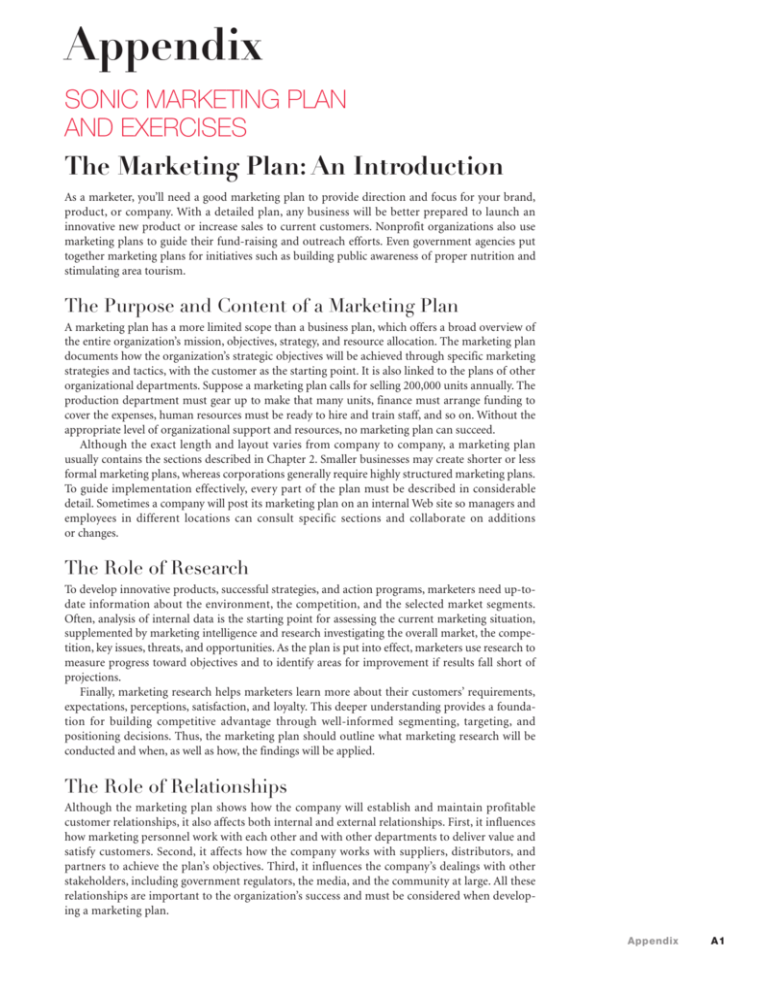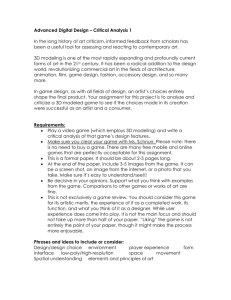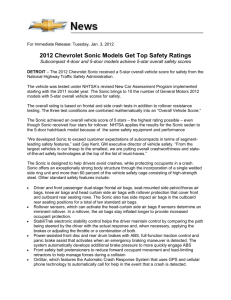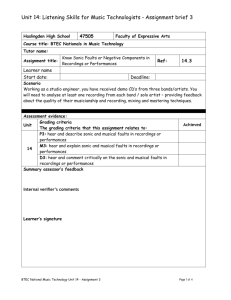Sonic Marketing Plan
advertisement

Appendix SONIC MARKETING PLAN AND EXERCISES The Marketing Plan: An Introduction As a marketer, you’ll need a good marketing plan to provide direction and focus for your brand, product, or company. With a detailed plan, any business will be better prepared to launch an innovative new product or increase sales to current customers. Nonprofit organizations also use marketing plans to guide their fund-raising and outreach efforts. Even government agencies put together marketing plans for initiatives such as building public awareness of proper nutrition and stimulating area tourism. The Purpose and Content of a Marketing Plan A marketing plan has a more limited scope than a business plan, which offers a broad overview of the entire organization’s mission, objectives, strategy, and resource allocation. The marketing plan documents how the organization’s strategic objectives will be achieved through specific marketing strategies and tactics, with the customer as the starting point. It is also linked to the plans of other organizational departments. Suppose a marketing plan calls for selling 200,000 units annually. The production department must gear up to make that many units, finance must arrange funding to cover the expenses, human resources must be ready to hire and train staff, and so on. Without the appropriate level of organizational support and resources, no marketing plan can succeed. Although the exact length and layout varies from company to company, a marketing plan usually contains the sections described in Chapter 2. Smaller businesses may create shorter or less formal marketing plans, whereas corporations generally require highly structured marketing plans. To guide implementation effectively, every part of the plan must be described in considerable detail. Sometimes a company will post its marketing plan on an internal Web site so managers and employees in different locations can consult specific sections and collaborate on additions or changes. The Role of Research To develop innovative products, successful strategies, and action programs, marketers need up-todate information about the environment, the competition, and the selected market segments. Often, analysis of internal data is the starting point for assessing the current marketing situation, supplemented by marketing intelligence and research investigating the overall market, the competition, key issues, threats, and opportunities. As the plan is put into effect, marketers use research to measure progress toward objectives and to identify areas for improvement if results fall short of projections. Finally, marketing research helps marketers learn more about their customers’ requirements, expectations, perceptions, satisfaction, and loyalty. This deeper understanding provides a foundation for building competitive advantage through well-informed segmenting, targeting, and positioning decisions. Thus, the marketing plan should outline what marketing research will be conducted and when, as well as how, the findings will be applied. The Role of Relationships Although the marketing plan shows how the company will establish and maintain profitable customer relationships, it also affects both internal and external relationships. First, it influences how marketing personnel work with each other and with other departments to deliver value and satisfy customers. Second, it affects how the company works with suppliers, distributors, and partners to achieve the plan’s objectives. Third, it influences the company’s dealings with other stakeholders, including government regulators, the media, and the community at large. All these relationships are important to the organization’s success and must be considered when developing a marketing plan. Appendix A1 From Marketing Plan to Marketing Action Most companies create yearly marketing plans, although some plans cover a longer period. Marketers start planning well in advance of the implementation date to allow time for marketing research, analysis, management review, and coordination between departments. Then, after each action program begins, marketers monitor ongoing results, investigate any deviation from the projected outcome, and take corrective steps as needed. Some marketers also prepare contingency plans for implementation if certain conditions emerge. Because of inevitable and sometimes unpredictable environmental changes, marketers must be ready to update and adapt marketing plans at any time. For effective implementation and control, the marketing plan should define how progress toward objectives will be measured. Managers typically use budgets, schedules, and marketing metrics for monitoring and evaluating results. With budgets, they can compare planned expenditures with actual expenditures for a given period. Schedules allow management to see when tasks were supposed to be completed and when they were actually completed. Marketing metrics track the actual outcomes of marketing programs to see whether the company is moving forward toward its objectives. Sample Marketing Plan for Sonic This section takes you inside the sample marketing plan for Sonic, a hypothetical start-up company. The company’s first product is the Sonic 1000, a state-of-the-art, fully loaded multimedia smart phone. Sonic will be competing with Apple, BlackBerry, Motorola, Nokia, Samsung, and other well-established rivals in a crowded, fast-changing marketplace where smart phones have many communication and entertainment capabilities. The annotations explain more about what each section of the plan should contain. This section summarizes market opportunities, marketing strategy, and marketing and financial objectives for senior managers who will read and approve the marketing plan. 1.0 Executive Summary The situation analysis describes the market, the company’s capability to serve targeted segments, and the competition. 2.0 Situation Analysis Market summary includes size, needs, growth, and trends. Describing the targeted segments in detail provides context for marketing strategies and programs discussed later in the plan. 2.1 Market Summary Sonic’s market consists of consumers and business users who prefer to A2 Appendix Sonic is preparing to launch a major new state-of-the-art multimedia smart phone, the Sonic 1000, in a mature market. We can effectively compete with many types of smart phones because our product offers a unique combination of advanced features and functionality at a very competitive value-added price. We are targeting specific segments in the consumer and business markets, taking advantage of the growing interest in a single powerful but affordable device with extensive communication, organization, and entertainment benefits. The primary marketing objective is to achieve first-year U.S. market share of 1 percent with unit sales of 800,000. The primary financial objectives are to achieve first-year sales revenues of $200 million, keep first-year losses to less than $40 million, and break even early in the second year. Sonic, founded 18 months ago by two well-known entrepreneurs with telecommunications experience, is about to enter the highly competitive smart phone market. Multifunction cell phones are increasingly popular for both personal and professional use, with more than 320 million smart phones sold worldwide in 2010. Competition is increasingly intense even as technology evolves, industry consolidation continues, and pricing pressures squeeze profitability. Palm, a PDA pioneer, is one of several key players having difficulty adapting to the smart phone challenge. To gain market share in this dynamic environment, Sonic must carefully target specific segments with valued features and plan for a next-generation product to keep brand momentum going. use a powerful but affordable single device for fully functional communication, information storage and exchange, organization, and entertainment on the go. Specific segments being targeted during the first year include professionals, corporations, students, entrepreneurs, and medical users. Exhibit A.1 shows how the Sonic 1000 addresses some of the most basic needs of targeted consumer and business segments in a cost-effective manner. The additional communication and entertainment benefits of the product just enhance its appeal to those segments. Smart phone purchasers can choose between models based on several different operating systems. The biggest selling smart phone operating system is Symbian OS. Symbian’s smaller rivals Targeted Segment Customer Need Corresponding Feature/Benefit Professionals (consumer market) ■ Stay in touch while on the go ■ Wireless e-mail to conveniently send and receive messages from Students (consumer market) anywhere; cell phone capability for voice communication from anywhere ■ Record information while on the go ■ Voice recognition for no-hands recording ■ Perform many functions without carrying ■ Compatible with numerous applications and peripherals for multiple gadgets ■ Express style and individuality convenient, cost-effective functionality ■ Case wardrobe of different colors and patterns allows users to make a fashion statement Corporate users (business market) ■ Input and access critical data on the go ■ Compatible with widely available software ■ Use for proprietary tasks ■ Customizable to fit diverse corporate tasks and networks Entrepreneurs (business market) ■ Organize and access contacts, schedule ■ No-hands, wireless access to calendar and address book to easily Medical users (business market) ■ Update, access, and exchange medical details records check appointments and connect with contacts ■ No-hands, wireless recording and exchange of information to reduce paperwork and increase productivity |Exh. A.1| Needs and Corresponding Features/Benefits of Sonic Smart Phone include Android, BlackBerry OS, iOS, and the Windows Phone OS. Several mobile operating systems including Android and iOS are based on Linux and Unix. Sonic licenses a Linux-based system because it is somewhat less vulnerable to attack by hackers and viruses. Storage capacity (hard drive or flash drive) is an expected feature, so Sonic is equipping its first product with an ultra-fast 64-gigabyte drive that can be supplemented by extra storage. Technology costs are decreasing even as capabilities are increasing, which makes value-priced models more appealing to consumers and to business users with older smart phones who want to trade up to new, high-end multifunction units. 2.2 Strengths,Weaknesses, Opportunities, and Threat Analysis Sonic has several powerful strengths on which to build, but our major weakness is lack of brand awareness and image. The major opportunity is demand for multifunction communication, organization, and entertainment devices that deliver a number of valued benefits at a lower cost. We also face the threat of ever-higher competition and downward pricing pressure. Strengths Sonic can build on three important strengths: 1. 2. 3. Innovative product—The Sonic 1000 offers a combination of features that are hard to find in single devices, with extensive telecommunications capabilities and highest quality digital video/music/TV program storage/playback. Security—Our smart phone uses a Linux-based operating system that is less vulnerable to hackers and other security threats that can result in stolen or corrupted data. Pricing—Our product is priced lower than competing smart phones—none of which offer the same bundle of features—which gives us an edge with price-conscious customers. Weaknesses By waiting to enter the smart phone market until considerable consolidation of competitors has occurred, Sonic has learned from the successes and mistakes of others. Nonetheless, we have two main weaknesses: 1. 2. Strengths are internal capabilities that can help the company reach its objectives. Weaknesses are internal elements that may interfere with the company’s ability to achieve its objectives. Lack of brand awareness—Sonic has no established brand or image, whereas Samsung, Apple, Motorola, and others have strong brand recognition. We will address this issue with aggressive promotion. Heavier and thicker unit—The Sonic 1000 is slightly heavier and thicker than most competing models because it incorporates so many telecommunication and multimedia features. To counteract this weakness, we will emphasize our product’s benefits and value-added pricing, two compelling competitive strengths. Appendix A3 Opportunities are areas of buyer need or potential interest in which the company might perform profitably. Opportunities Sonic can take advantage of two major market opportunities: 1. 2. Threats are challenges posed by an unfavorable trend or development that could lead to lower sales and profits. Threats We face three main threats at the introduction of the Sonic 1000: 1. 2. 3. This section identifies key competitors, describes their market positions, and provides an overview of their strategies. Increasing demand for state-of-the-art multimedia devices with a full array of communication functions—The market for cutting-edge multimedia, multifunction devices is growing much rapidly. Smart phones are already commonplace in public, work, and educational settings; in fact, users who bought entry-level models are now trading up. Lower technology costs—Better technology is now available at a lower cost than ever before. Thus, Sonic can incorporate advanced features at a value-added price that allows for reasonable profits. Increased competition—More companies are offering devices with some but not all of the features and benefits provided by the Sonic 1000. Therefore, Sonic’s marketing communications must stress our clear differentiation and value-added pricing. Downward pressure on pricing—Increased competition and market share strategies are pushing smart phone prices down. Still, our objective of breaking even with second-year sales of the original model is realistic, given the lower margins in the smart phone market. Compressed product life cycle—Smart phones are reaching the maturity stage of their life cycle more quickly than earlier technology products. Because of this compressed life cycle, we plan to introduce an even greater enhanced media-oriented second product during the year following the Sonic 1000’s launch. 2.3 Competition The emergence of well-designed multifunction smart phones, including the Apple iPhone, has increased competitive pressure. Competitors are continually adding features and sharpening price points. Key competitors: • • • • • Motorola. Motorola has a long tradition of successful cell phones—it sold millions and millions of its RAZR clamshell phones worldwide. It has struggled in recent years, however, to keep up with competition. Apple. The initial iPhone, a smart phone with a 3.5-inch color screen, was designed with entertainment enthusiasts in mind. It’s well equipped for music, video, and Web access, plus calendar and contact management functions. Apple initially partnered only with the AT&T network and cut the product’s price to $399 two months after introduction to speed market penetration. RIM. Research In Motion makes the lightweight BlackBerry wireless phone/PDA products that are popular among corporate users. RIM’s continuous innovation and solid customer service support strengthen its competitive standing as it introduces more smart phones and PDAs. Samsung. Value, style, function: Samsung is a powerful competitor, offering a variety of smart phones and Ultra-Mobile PCs for consumer and business segments. Some of its smart phones are available for specific telecommunications carriers and some are “unlocked,” ready for any compatible telecommunications network. Nokia. With a presence in virtually every possible cell phone market, Nokia is always an experienced, formidable opponent. Having launched one of the early smart phones, it will be expected to aggressively compete in the smart phone market. Despite strong competition, Sonic can carve out a definite image and gain recognition among targeted segments. Our appealing combination of state-of-the-art features and low price is a critical point of differentiation for competitive advantage. Our second product will be even more mediaoriented to appeal to segments where we will have strong brand recognition. Exhibit A.2 shows a sample of competitive products and prices. This section summarizes the main features of the company’s various products. A4 Appendix 2.4 Product Offerings The Sonic 1000 offers the following standard features: • • • • • • Voice recognition for hands-free operation Full array of apps Complete organization functions, including linked calendar, address book, synchronization Digital music/video/television recording, wireless downloading, and instant playback Wireless Web and e-mail, text messaging, instant messaging Four-inch high-quality color touch screen Samsung Galaxy S - Captivate Apple iPhone 4 Motorola Droid Pro Nokia N900 BlackBerry Storm 2 9550 Storage 32 GB memory card 32 GB flash drive Supports up to 32 GB micro SD Up to 32 GB Internal 16 GB mirco SD (sold separately) 2GB eMMC 16MB media card included Display WVGA 4" touch screen Retina display 3.5” (diagonal) widescreen multi-touch screen HGVA 3.1” touch screen WVGA 3.5” touch screen 3.25" touch screen Camera Auto focus 5.0 MP 4× digital zoom Video MPEG4, AAC, AAC+ H.263 H.264 Video streaming Tap to focus 5.0 MP VGA quality photos LED flash Video recording Geotagging Auto focus 5 MP Digital zoom LED flash Image editing tools Auto focus with two-stage capture key 5 MP Dual LED flash Image editing tools Geotagging Auto focus 3.2 MP 2x digital zoom Flash Auto focus Image stabilization Video recording Price $449-$599 $723 $199 16 GB $299 32 GB $449–$489 $349 $349 |Exh. A.2| Selected Smart Phone Products and Pricing • • Ultra-fast 64-gigabyte drive and expansion slots Integrated 12 megapixel camera with flash and photo editing/sharing tools First-year sales revenues are projected to be $200 million, based on sales of 800,000 of the Sonic 1000 model at a wholesale price of $250 each. Our second-year product will be the Sonic All Media 2000, stressing enhanced multimedia communication, networking, and entertainment functions. The Sonic All Media 2000 will include Sonic 1000 features plus additional features such as: • • • Built-in media beaming to share music, video, and television files with other devices Webcam for instant video capture and uploading to popular video Web sites Voice-command access to popular social networking Web sites 2.5 Distribution Sonic-branded products will be distributed through a network of retailers in the top 50 U.S. markets. Among the most important channel partners being contacted are: • • • • Office supply superstores. Office Max, Office Depot, and Staples will all carry Sonic products in stores, in catalogs, and online. Computer stores. CompUSA and independent computer retailers will carry Sonic products. Electronics specialty stores. Best Buy will feature Sonic smart phones in its stores, online, and in its media advertising. Online retailers. Amazon.com will carry Sonic smart phones and, for a promotional fee, will give Sonic prominent placement on its homepage during the introduction. Distribution explains each channel for the company’s products and mentions new developments and trends. Distribution will initially be restricted to the United States, with appropriate sales promotion support. Later, we plan to expand into Canada and beyond. 3.0 Marketing Strategy 3.1 Objectives We have set aggressive but achievable objectives for the first and second years of market entry. • • First-Year Objectives. We are aiming for a 1 percent share of the U.S. smart phone market through unit sales volume of 800,000. Second-Year Objectives. Our second-year objective is to achieve break-even on the Sonic 1000 and launch our second model. Objectives should be defined in specific terms so management can measure progress and take corrective action to stay on track. Appendix A5 All marketing strategies start with segmentation, targeting, and positioning. 3.2 Target Markets Sonic’s strategy is based on a positioning of product differentiation. Our primary consumer target for the Sonic 1000 is middle- to upper-income professionals who need one fully loaded device to coordinate their busy schedules, stay in touch with family and colleagues, and be entertained on the go. Our secondary consumer target is high school, college, and graduate students who want a multimedia, dual-mode device. This segment can be described demographically by age (16–30) and education status. Our Sonic All Media 2000 will be aimed at teens and twentysomethings who want a device with features to support social networking and heavier, more extensive entertainment media consumption. The primary business target for the Sonic 1000 is mid- to large-sized corporations that want to help their managers and employees stay in touch and input or access critical data when out of the office. This segment consists of companies with more than $25 million in annual sales and more than 100 employees. A secondary target is entrepreneurs and small business owners. Also we will target medical users who want to update or access patients’ medical records. Each of the marketing-mix strategies conveys Sonic’s differentiation to these target market segments. Positioning identifies the brand, benefits, points of difference, and parity for the product or line. 3.3 Positioning Using product differentiation, we are positioning the Sonic smart phone as the most versatile, convenient, value-added model for personal and professional use. Our marketing will focus on the value-priced multiple communication, entertainment, and information capabilities differentiating the Sonic 1000. 3.4 Strategies Product strategy includes decisions about product mix and lines, brands, packaging and labeling, and warranties. Product The Sonic 1000, including all the features described in the earlier Product Review section Pricing strategy covers decisions about setting initial prices and adapting prices in response to opportunities and competitive challenges. Pricing The Sonic 1000 will be introduced at a $250 wholesale price and a $300 estimated retail Distribution strategy includes selection and management of channel relationships to deliver value to customers. Distribution Our channel strategy is to use selective distribution, marketing Sonic smart phones through well-known stores and online retailers. During the first year, we will add channel partners until we have coverage in all major U.S. markets and the product is included in the major electronics catalogs and Web sites. We will also investigate distribution through cell-phone outlets maintained by major carriers such as Verizon Wireless. In support of channel partners, we will provide demonstration products, detailed specification handouts, and full-color photos and displays featuring the product. Finally, we plan to arrange special payment terms for retailers that place volume orders. Marketing communications strategy covers all efforts to communicate to target audiences and channel members. Marketing Communications By integrating all messages in all media, we will reinforce the brand name and the main points of product differentiation. Research about media consumption patterns will help our advertising agency choose appropriate media and timing to reach prospects before and during product introduction. Thereafter, advertising will appear on a pulsing basis to maintain brand awareness and communicate various differentiation messages. The agency will also coordinate public relations efforts to build the Sonic brand and support the differentiation message. To generate buzz, we will host a user-generated video contest on our Web site. To attract, retain, and motivate channel partners for a push strategy, we will use trade sales promotions and personal selling. Until the Sonic brand has been established, our communications will encourage purchases through channel partners rather than from our Web site. The marketing mix includes tactics and programs that support product, pricing, distribution, and marketing communications strategy. 3.5 Marketing Mix The Sonic 1000 will be introduced in February. Here are summaries of action programs we will use during the first six months to achieve our stated objectives. A6 Appendix and more, will be sold with a one-year warranty. We will introduce the Sonic All Media 2000 during the following year, after we have established our Sonic brand. The brand and logo (Sonic’s distinctive yellow thunderbolt) will be displayed on our products and packaging as well as in all marketing campaigns. price per unit. We expect to lower the price of this model when we expand the product line by launching the Sonic All Media 2000, to be priced at $350 wholesale per unit. These prices reflect a strategy of (1) attracting desirable channel partners and (2) taking share from established competitors. • January. We will launch a $200,000 trade sales promotion campaign and participate in major industry trade shows to educate dealers and generate channel support for the product launch • • • • • in February. Also, we will create buzz by providing samples to selected product reviewers, opinion leaders, influential bloggers, and celebrities. Our training staff will work with retail sales personnel at major chains to explain the Sonic 1000’s features, benefits, and advantages. February. We will start an integrated print/radio/Internet campaign targeting professionals and consumers. The campaign will show how many functions the Sonic smart phone can perform and emphasize the convenience of a single, powerful handheld device. This multimedia campaign will be supported by point-of-sale signage as well as online-only ads and video tours. March. As the multimedia advertising campaign continues, we will add consumer sales promotions such as a contest in which consumers post videos to our Web site, showing how they use the Sonic in creative and unusual ways. We will also distribute new point-of-purchase displays to support our retailers. April. We will hold a trade sales contest offering prizes for the salesperson and retail organization that sells the most Sonic smart phones during the four-week period. May. We plan to roll out a new national advertising campaign this month. The radio ads will feature celebrity voices telling their Sonic smart phones to perform functions such as initiating a phone call, sending an e-mail, playing a song or video, and so on. The stylized print and online ads will feature avatars of these celebrities holding their Sonic smart phones. We plan to repeat this theme for next year’s product launch. June. Our radio campaign will add a new voice-over tagline promoting the Sonic 1000 as a graduation gift. We will exhibit at the semiannual electronics trade show and provide retailers with new competitive comparison handouts as a sales aid. In addition, we will analyze the results of customer satisfaction research for use in future campaigns and product development efforts. Programs should coordinate with the resources and activities of other departments that contribute to customer value for each product. 3.6 Marketing Research Using research, we will identify specific features and benefits our target market segments value. Feedback from market tests, surveys, and focus groups will help us develop and fine-tune the Sonic All Media 2000. We are also measuring and analyzing customers’ attitudes toward competing brands and products. Brand awareness research will help us determine the effectiveness and efficiency of our messages and media. Finally, we will use customer satisfaction studies to gauge market reaction. This section shows how marketing research will support the development, implementation, and evaluation of marketing strategies and programs. 4.0 Financials Financials include budgets and forecasts to plan for marketing expenditures, scheduling, and operations. Total first-year sales revenue for the Sonic 1000 is projected at $200 million, with an average wholesale price of $250 per unit and variable cost per unit of $150 for unit sales volume of 800,000. We anticipate a first-year loss of up to $40 million. Break-even calculations indicate that the Sonic 1000 will become profitable after the sales volume exceeds 267,500 during the product’s second year. Our break-even analysis assumes per-unit wholesale revenue of $250 per unit, variable cost of $150 per unit, and estimated first-year fixed costs of $26,750,000. With these assumptions, the break-even calculation is: 26,750,000 = 267,500 units $250 - $150 5.0 Controls Controls are being established to cover implementation and the organization of our marketing activities. 5.1 Implementation We are planning tight control measures to closely monitor quality and customer service satisfaction. This will enable us to react very quickly in correcting any problems that may occur. Other early warning signals that will be monitored for signs of deviation from the plan include monthly sales (by segment and channel) and monthly expenses. 5.2 Marketing Organization Sonic’s chief marketing officer, Jane Melody, holds overall responsibility for all of the company’s marketing activities. Exhibit A.3 shows the structure Controls help management measure results and identify any problems or performance variations that need corrective action. The marketing department may be organized by function, as in this sample, or by geography, product, customer, or some combination of these. Appendix A7 |Exh. A.3| Jane Melody, Chief Marketing Officer Sonic’s Marketing Organization Tony Calella, Sales Manager Tiffany White, Regional Sales Amelia Howard, Advertising Manager Carlos Dunn, Advertising Analyst Ron Hall, Promotion Manager Kate McConnell, Promotion Analyst Viktor Chenkov, Regional Sales of the eight-person marketing organization. Sonic has hired Worldwide Marketing to handle national sales campaigns, trade and consumer sales promotions, and public relations efforts. Sonic Marketing Plan Chapter Assignments1 Chapter 2 As an assistant to Jane Melody, Sonic’s chief marketing officer, you’ve been assigned to draft a mission statement for top management’s review. This should cover the competitive spheres within which the firm will operate and your recommendation of an appropriate generic competitive strategy. Using your knowledge of marketing, the information you have about Sonic, and library or Internet resources, answer the following questions. • • • What should Sonic’s mission be? In what competitive spheres (industry, products and applications, competence, marketsegment, vertical, and geographic) should Sonic operate? Which of Porter’s generic competitive strategies would you recommend Sonic follow in formulating overall strategy? As your instructor directs, enter your answers and supporting information in a written marketing plan or use Marketing Plan Pro software to document your ideas. Chapter 3 Jane Melody asks you to scan Sonic’s external environment for early warning signals of new opportunities and emerging threats that could affect the success of the Sonic 1000 smart phone. Using Internet or library sources (or both), locate information to answer three questions about key areas of the macroenvironment. • • • What demographic changes are likely to affect Sonic’s targeted segments? What economic trends might influence buyer behavior in Sonic’s targeted segments? How might the rapid pace of technological change/alter Sonic’s competitive situation? Enter your answers about Sonic’s environment in the appropriate sections of a written marketing plan or use the Marketing Plan Pro software to record your comments. A8 Appendix Chapter 4 Your next task is to consider how marketing research can help Sonic support its marketing strategy. Jane Melody also asks you how Sonic can measure results after the marketing plan is implemented. She wants you to answer the following three questions. • • • What surveys, focus groups, observation, behavioral data, or experiments will Sonic need to support its marketing strategy? Be specific about the questions or issues that Sonic needs to resolve using marketing research. Where can you find suitable secondary data about total demand for smart phones over the next two years? Identify at least two sources (online or offline), describe what you plan to draw from each source, and indicate how the data would be useful for Sonic’s marketing planning. Recommend three specific marketing metrics for Sonic to apply in determining marketing effectiveness and efficiency. Enter this information in the marketing plan you’ve been writing or use the Marketing Plan Pro software to document your responses. Chapter 5 Sonic has decided to focus on total customer satisfaction as a way of encouraging brand loyalty in a highly competitive marketplace. With this in mind, you’ve been assigned to analyze three specific issues as you continue working on Sonic’s marketing plan. • • • How (and how often) should Sonic monitor customer satisfaction? Would you recommend that Sonic use the Net Promoter method? Explain your reasoning. Which customer touch points should Sonic pay particularly close attention to, and why? Consider your answers in the context of Sonic’s current situation and the objectives it has set. Then enter your latest decisions in the written marketing plan or using Marketing Plan Pro software. Chapter 6 You’re responsible for researching and analyzing the consumer market for Sonic’s smart phone product. Look again at the data you’ve already entered about the company’s current situation and macroenvironment, especially the market being targeted. Now answer these questions about the market and buyer behavior. • • • What cultural, social, and personal factors are likely to most influence consumer purchasing of smart phones? What research tools would help you better understand the effect on buyer attitudes and behavior? Which aspects of consumer behavior should Sonic’s marketing plan emphasize and why? What marketing activities should Sonic plan to coincide with each stage of the consumer buying process? After you’ve analyzed these aspects of consumer behavior, consider the implications for Sonic’s marketing efforts to support the launch of its smart phone. Finally, document your findings and conclusions in a written marketing plan or with Marketing Plan Pro. Chapter 7 You’ve been learning more about the business market for Sonic’s smart phone. Jane Melody has defined this market as mid- to large-sized corporations that want their employees to stay in touch and be able to input or access data from any location. Respond to the following three questions based on your knowledge of Sonic’s current situation and business-to-business marketing. • • • What types of businesses appear to fit Melody’s market definition? How can you research the number of employees and find other data about these types of businesses? What type of purchase would a Sonic smart phone represent for these businesses? Who would participate in and influence this type of purchase? Would demand for smart phones among corporate buyers tend to be inelastic? What are the implications for Sonic’s marketing plan? Appendix A9 Your answers to these questions will affect how Sonic plans marketing activities for the business segments to be targeted. Take a few minutes to note your ideas in a written marketing plan or using Marketing Plan Pro. Chapter 8 Identifying suitable market segments and selecting targets are critical to the success of any marketing plan. As Jane Melody’s assistant, you’re responsible for market segmentation and targeting. Look back at the market information, buyer behavior data, and competitive details you previously gathered as you answer the following questions. • • • Which variables should Sonic use to segment its consumer and business markets? How can Sonic evaluate the attractiveness of each identified segment? Should Sonic market to one consumer segment and one business segment or target more than one in each market? Why? Should Sonic pursue full market coverage, market specialization, product specialization, selective specialization, or single-segment concentration? Why? Next, consider how your decisions about segmentation and targeting will affect Sonic’s marketing efforts. Depending on your instructor’s directions, summarize your conclusions in a written marketing plan or use Marketing Plan Pro. Chapter 9 Sonic is a new brand with no prior brand associations, which presents a number of marketing opportunities and challenges. Jane Melody has given you responsibility for making recommendations about three brand equity issues that are important to Sonic’s marketing plan. • • • What brand elements would be most useful for differentiating the Sonic brand from competing brands? How can Sonic sum up its brand promise for the new smart phone? Should Sonic add a brand for its second product or retain the Sonic name? Be sure your brand ideas are appropriate in light of what you’ve learned about your targeted segments and the competition. Then add this information to your written marketing plan or the plan you’ve been developing with Marketing Plan Pro software. Chapter 10 As before, you’re working with Jane Melody on Sonic’s marketing plan for launching a new smart phone. Now you’re focusing on Sonic’s positioning and product life-cycle strategies by answering three specific questions. • • • In a sentence or two, what is an appropriate positioning for the Sonic 1000 smart phone? Knowing the stage of Sonic’s smart phone in the product life cycle, what are the implications for pricing, promotion, and distribution? In which stage of its evolution does the smart phone market appear to be? What does this mean for Sonic’s marketing plans? Document your ideas in a written marketing plan or in Marketing Plan Pro. Note any additional research you may need to determine how to proceed after the Sonic 1000 has been launched. Chapter 11 Sonic is a new entrant in an established industry characterized by competitors with relatively high brand identity and strong market positions. Use research and your knowledge of how to deal with competitors to consider three issues that will affect the company’s ability to successfully introduce its first product: • • A10 Appendix What factors will you use to determine Sonic’s strategic group? Should Sonic select a class of competitor to attack on the basis of strength versus weakness, closeness versus distance, or good versus bad? Why is this appropriate in the smart phone market? • As a start-up company, what competitive strategy would be most effective as Sonic introduces its first product? Take time to analyze how Sonic’s competitive strategy will affect its marketing strategy and tactics. Now summarize your ideas in a written marketing plan or using Marketing Plan Pro software. Chapter 12 Introducing a new product entails a variety of decisions about product strategy, including differentiation, ingredient branding, packaging, labeling, warranty, and guarantee. Your next task is to answer the following questions about Sonic’s product strategy. • • • Which aspect of product differentiation would be most valuable in setting Sonic apart from its competitors, and why? Should Sonic use ingredient branding to tout the Linux-based operating system that it says makes its smart phone more secure than smart phones based on some other operating systems? How can Sonic use packaging and labeling to support its brand image and help its channel partners sell the smart phone product more effectively? Once you’ve answered these questions, incorporate your ideas into the marketing plan you’ve been writing or document them using the Marketing Plan Pro software. Chapter 13 You’re planning customer support services for Sonic’s new smart phone product. Review what you know about your target market and its needs; also think about what Sonic’s competitors are offering. Then respond to these three questions about designing and managing services. • • • What support services are buyers of smart phone products likely to want and need? How can Sonic manage gaps between perceived service and expected service to satisfy customers? What postsale service arrangements must Sonic make and how would you expect these to affect customer satisfaction? Consider how your service strategy will support Sonic’s overall marketing efforts. Summarize your recommendations in a written marketing plan or use Marketing Plan Pro to document your ideas. Chapter 14 You’re in charge of pricing Sonic’s product for its launch early next year. Review the SWOT analysis you previously prepared as well as Sonic’s competitive environment, targeting strategy, and product positioning. Now continue working on your marketing plan by responding to the following questions. • • • What should Sonic’s primary pricing objective be? Explain your reasoning. Are smart phone customers likely to be price sensitive? What are the implications for your pricing decisions? What price adaptations (such as discounts, allowances, and promotional pricing) should Sonic include in its marketing plan? Make notes about your answers to these questions and then document the information in a written marketing plan or use Marketing Plan Pro software, depending on your instructor’s directions. Chapter 15 At Sonic, you have been asked to develop a marketing channel system for the new Sonic 1000 smart phone. Based on what you know about designing and managing integrated marketing channels, answer the three questions that follow. • • • Do you agree with Jane Melody’s decision to use a push strategy for the new product? Explain your reasoning. How many channel levels are appropriate for Sonic’s targeted consumer and business segments? In determining the number of channel members, should you use exclusive, selective, or intensive distribution? Why? Appendix A11 Be sure your marketing channel ideas support the product positioning and are consistent with the goals that have been set. Record your recommendations in a written marketing plan or use Marketing Plan Pro. Chapter 16 At this point, you need to make more specific decisions about managing the marketing intermediaries for Sonic’s first product. Formulate your ideas by answering the following questions. • • • What types of retailers would be most appropriate for distributing Sonic’s smart phone? What are the advantages and disadvantages of selling through these types of retailers? What role should wholesalers play in Sonic’s distribution strategy? Why? What market-logistics issues must Sonic consider for the launch of its first smart phone? Summarize your decisions about retailing, wholesaling, and logistics in the marketing plan you’ve been writing or in the Marketing Plan Pro software. Chapter 17 Jane Melody has assigned you to plan integrated marketing communications for Sonic’s new product introduction. Review the data, decisions, and strategies you previously documented in your marketing plan before you answer the next three questions. • • • What communications objectives are appropriate for Sonic’s initial campaign? How can Sonic use personal communications channels to influence its target audience? Which communication tools would you recommend using after Sonic’s initial product has been in the market for six months? Why? Confirm that your marketing communications plans make sense in light of Sonic’s overall marketing efforts. Now, as your instructor directs, summarize your thoughts in a written marketing plan or in the Marketing Plan Pro software. Chapter 18 Mass communications will play a key role in Sonic’s product introduction. After reviewing your earlier decisions and thinking about the current situation (especially your competitive circumstances), respond to the following questions to continue planning Sonic’s marketing communications strategy. • • • Once Sonic begins to use consumer advertising, what goals would be appropriate? Should Sonic continue consumer and trade sales promotion after the new product has been in the market for six months? Explain your reasoning. Jane Melody wants you to recommend an event sponsorship possibility that would be appropriate for the new product campaign. What type of event would you suggest and what objectives would you set for the sponsorship? Record your ideas about mass communications in the marketing plan you’ve been writing or use Marketing Plan Pro. Chapter 19 Sonic needs a strategy for managing personal communications during its new product launch. This is the time to look at interactive marketing, word of mouth, and personal selling. Answer these three questions as you consider Sonic’s personal communications strategy. • • • Which forms of interactive marketing are appropriate for Sonic, given its objectives, mass communications arrangements, and channel decisions? How should Sonic use word of mouth to generate brand awareness and encourage potential buyers to visit retailers to see the new smart phone in person? Does Sonic need a direct sales force or can it sell through agents and other outside representatives? Look back at earlier decisions and ideas before you document your comments about personal communications in your written marketing plan or using Marketing Plan Pro software. A12 Appendix Chapter 20 Knowing that the smart phone market is likely to remain highly competitive, Jane Melody wants you to look ahead at how Sonic can develop new products outside the smart phone market. Review the competitive situation and the market situation before you continue working on the Sonic marketing plan. • • • List three new-product ideas that build on Sonic’s strengths and the needs of its various target segments. What criteria should Sonic use to screen these ideas? Develop the most promising idea into a product concept and explain how Sonic can test this concept. What particular dimensions must be tested? Assume that the most promising idea tests well. Now develop a marketing strategy for introducing it, including a description of the target market; the product positioning; the estimated sales, profit, and market share goals for the first year; your channel strategy; and the marketing budget you will recommend for this new product introduction. If possible, estimate Sonic’s costs and conduct a break-even analysis. Document all the details of your new-product development ideas in the written marketing plan or use Marketing Plan Pro software. Chapter 21 As Jane Melody’s assistant, you’re researching how to market the Sonic 1000 smart phone product outside the United States within a year. You’ve been asked to answer the following questions about Sonic’s use of global marketing. • • • As a start-up company, should Sonic use indirect or direct exporting, licensing, joint ventures, or direct investment to enter the Canadian market next year? To enter other markets? Explain your answers. If Sonic starts marketing its smart phone in other countries, which of the international product strategies is most appropriate? Why? Although some components are made in Asia, Sonic’s smart phones will be assembled in Mexico through a contractual arrangement with a local factory. How are country-of-origin perceptions likely to affect your marketing recommendations? Think about how these global marketing issues fit into Sonic’s overall marketing strategy. Now document your ideas in the marketing plan you’ve been writing or using Marketing Plan Pro. Chapter 22 With the rest of the marketing plan in place, you’re ready to make recommendations about how to manage Sonic’s marketing activities. Here are some specific questions Jane Melody wants you to consider. • • • How can Sonic drive customer-focused marketing and strategic innovation throughout the organization? What role should social responsibility play in Sonic’s marketing? How can Sonic evaluate its marketing? Suggest several specific steps the company should take. To complete your marketing plan, enter your answers to these questions in the written marketing plan or in Marketing Plan Pro software. Finally, draft the executive summary of the plan’s highlights. Appendix A13








